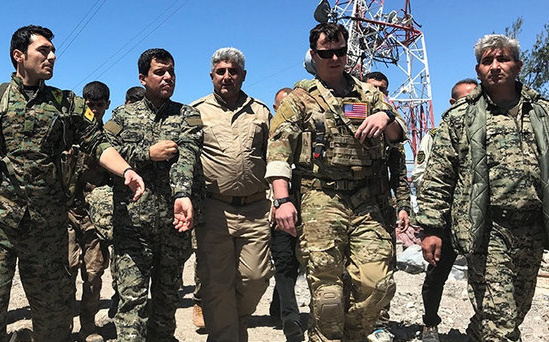US commander with colleagues of the Kurdish militia YPG in northeast Syria, April 2017
There was confusion on Sunday over the future US troop presence in Syria, with the country’s top commander denying a report — citing American officials — that up to 1,000 are remaining despite Donald Trump’s withdrawal order in December.
Gen. Joseph Dunford, the chairman of the Joint Chiefs of Staff, said a Wall Street Journal article is “factually incorrect: “There has been no change to the plan announced in February and we continue to implement the President’s direction to draw down U.S. forces to a residual presence.”
A US official said some plans are now based on more than 400 troops, but no final decisions have been made and other numbers are possible.
However, the official indirectly supported the Journal’s depiction. He pointed to the intention for more than 1,500 troops, from the US and European allies, in Kurdish areas of northern and eastern Syria.
Because France and the UK have made no firm pledges, the total American contribution may have to increase.
A “senior Administration official” insisted, “There will be a substantial withdrawal,” but added, “Final nubers are neither determined nor approved.”
Pushing Back Trump
The US military and officials such as National Security John Bolton have pushed back against Trump’s impulsive decision to remove all 2,000 personnel, made during a December 14 phone call with Turkish President Recep Tayyip Erdoğan. They have extended the timetable for any departure, and confirmed plans to keep at least 400 troops in Syria.
Half of the troops will remain alongside the Kurdish-led Syrian Democratic Forces, whom the US created in autumn 2015 to push back the Islamic State. ISIS has been reduced to the village of Baghouz on the Iraqi border.
The other half will remain in the US base at Tanf near Iraq.
The Pentagon and officials have cited concern over the resurgence of the Islamic State. They wish to maintain a counter against the presence of Iran, an essential ally of the Assad regime.
And the officials fear a Turkish offensive to take Kurdish-held areas, about 27% of Syria. Ankara considers the Kurdish YPG, the leading group in the SDF, as “terrorists” allied with the Turkish Kurdish insurgency PKK.
Erdoğan says Turkey will establish a 32-km (20-mile) deep “safe zone” in Kurdish territory along the Turkish-Syrian border. Talks between Ankara and the US have failed to reach agreement.
Dunford said on Sunday that the US and Turkey have an “initial concept” for the zone:
We continue to conduct detailed military planning with the Turkish General Staff to address Turkish security concerns along the Turkey-Syria border. Planning to date has been productive and we have an initial concept that will be refined in the coming days.
We are also conducting planning with other members of the Coalition who have indicated an intent to support the transition phase of operations into Syria.

